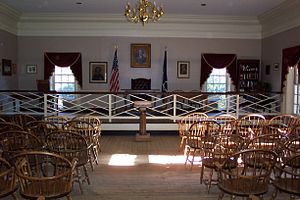On Friday February 2, 2013, I’ll be giving a talk about Frank Gehry’s design for the planned Eisenhower Memorial to the Jefferson Literary and Debating Society at the University of Virginia. The society, which claims to be the “oldest continuously existing collegiate debating society in North America,” was founded in 1825, the first year the university held classes. The event starts at 7:29 p.m. sharp.

I suppose I’ll be preaching to the choir, alas, since the room in which they meet is Jeffersonian classical (notice especially the rhythmic Chinese railing). A self-taught architect influenced by Palladio (but who sought to create an American national style–cf. the White House and Capitol, the designs of which he oversaw), President Thomas Jefferson designed the building to be a dining hall. However, the university turned it over to the society in 1837. The society’s use of the hall has been continuous except for the Civil War, when the Confederacy used it as a hospital.
To quote Jefferson:
How is a taste in this beautiful art [architecture] to be formed in our countrymen, unless we avail ourselves of every occasion when public buildings are to be erected, of presenting to them models for their study and imitation? . . . You see, I am an enthusiast on the subject of the arts. But it is an enthusiasm of which I am not ashamed, as its object is to improve the taste of my countrymen, to increase their reputation, to reconcile them to the rest of the world, and procure them its praise.
By contrast, Gehry has said:
I do think democracy has produced chaos, especially visual. A lot of people don’t like it and yearn for nineteenth-century images, forgetting that the politics of those images were different than the democracy we love.
***
Most of us believe in democracy, but the system has created a world that looks strange, chaotic, and different, and we do not like it. We are struggling and it is easier to go back to models which are more coherent and seem more seductive now. We have to remember that those models came under a different political time and philosophy. If we are to survive, we need to live in the present and try to work towards the future. I will reiterate what I have said many times: I cannot face my children it I tell them I have no more ideas and I have to copy something that happened before. It is like giving up and telling them there is no future for them.
***
I think of this in terms of controlled chaos. I always relate it to democracy. Democracy is pluralism, the collision of ideas. Our cities are built on a collision of thought. Look out there. There is a building by [architect I. M.] Pei, there is a bridge, there is that huge hunk in the distance. If it wasn’t for democracy it would all look like one thing. Stata [Gehry’s building at MIT] represents that idea, which is where I think we are in life now.
In his design for the National Memorial to President Eisenhower, Gehry has well-captured what he sees as the ugliness and chaos of democracy–a vision anathema to the Founding Fathers as well as Eisenhower himself. As the former Supreme Allied Commander, who had witnessed true chaos and destruction first-hand, said in 1962:
When we see our very art forms so changed that we seem to have forgotten the works of Michelangelo and Leonardo da Vinci, and speak in the present in terms of a piece of canvas that looks like a broken down [Model T Ford], loaded with paint, has been driven over it, is this improvement? What has happened to our concept of beauty and decency and morality?
Note that Gehry, like most leading contemporary architects, believes that architecture ought to slavishly kowtow to the alleged “Spirit of the Times”–no matter how deplorable those times are–as opposed to attempting to ameliorate them. Such architects are passive, feckless fatalists.

